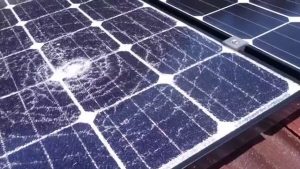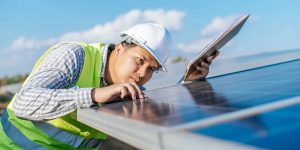*The glass industry in Mexico has a professional business platform, designed for the exchange of information, the presentation of products, services and technological innovation, including training sessions and lectures on current trends within the sector. Glasstech Mexico / Doors & Windows, will be held from July 9 to 11, 2024 at Expo Guadalajara. Please register as a trade visitor here: https://shorturl.at/J21b3
Spontaneous glass breakage in solar panels on the rise
The U.S. National Renewable Energy Laboratory (NREL) has observed an increase in spontaneous glass breakage in solar panels. The Renewable Energy Testing Center’s PV Module Index investigates this and other trends related to glass in solar panel manufacturing.
(via pv magazine)
Glass is a unique material used for its chemical stability and visual transparency. It is commonly used in solar panels as a protective outer layer.
In its annual index of photovoltaic modules, the Renewable Energy Testing Center (RETC) examined emerging issues in solar glass manufacturing and its performance in the field. It found a worrying increase in solar panel glass spontaneously breaking in the field, sometimes even before commissioning.
Teresa Barnes, Ph.D., leads the Photovoltaic Systems Reliability and Performance Group at the U.S. National Renewable Energy Laboratory (NREL). Barnes and her NREL colleagues reported the problem.
“Spontaneous glass breakage is an example of a failure mode we didn’t used to see. When I first started working on solar module reliability seven or eight years ago, we mostly heard about glass breakage when operations and maintenance practices were sloppy,” Barnes explains.
Now that’s no longer the case, and the NREL reliability team regularly receives reports of glass breakage in silicon modules not related to direct maintenance damage or storm impacts.” The team found that, over time, the average quality of solar glass appears to be declining.
“In the past, modules passed the IEC 61215 static load test with a large safety factor,” Barnes explains. “Today, modules barely pass the basic static load test or fail it with higher safety factors. Some new module designs simply fail the minimum static load test.”


The NREL team has begun to hypothesize that solar panel glass damage is undergoing a process similar to that of a car windshield that needs to be replaced. When a windshield suffers impact damage, it often only manifests as a small star-shaped mark that appears insignificant. But when extreme weather conditions occur with very high or very low temperatures, the severity of the damage becomes apparent and suddenly a large crack is visible across the entire surface.
“We believe that similar dynamics could be the main cause of spontaneous solar glass breakage,” Barnes says.
According to NREL, this increase in breakage is likely due to the tendency of solar glass to become thinner over time. Mike Pilliod of Central Tension, who spoke at NREL’s 2024 PV module reliability workshop, said that any manufacturer can temper 3 mm glass. But below 3 mm, tempering glass is a difficult process. He said that as the glass gets thinner, fewer flaws are needed to create defects that limit the strength of the glass. NREL is actively studying these defects to understand some of the potential pitfalls of using thin glass in solar panel manufacturing.
Barnes cautioned that it may be a combination of effects that is making glass breakage a greater threat than before. Modules are getting larger, frames are getting thinner, and mounting rails are getting closer together. All these factors result in “large, flexible modules” that put more pressure on the glass surface, which is also getting thinner in many modules.
According to the NREL team, at this year’s PV module reliability workshop, manufacturers began talking about introducing thicker frames and wider mounting positions.
“As you get a better understanding of how the module system interacts, you can work to optimize load balancing,” Barnes says. “The pendulum in that balancing act may already be swinging back toward the integrity of the frame and mounting rail.”
While some module suppliers focus on frames and mounting, others have introduced tempered glass modules that are marketed as resistant to hail and extreme weather.
RETC asked Barnes about recent catastrophic losses in Texas, where hail storms caused hundreds of millions of dollars in damage to operational solar assets.


